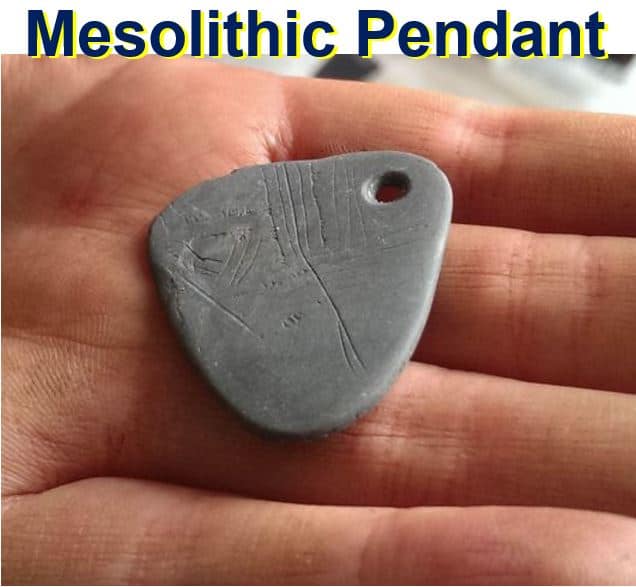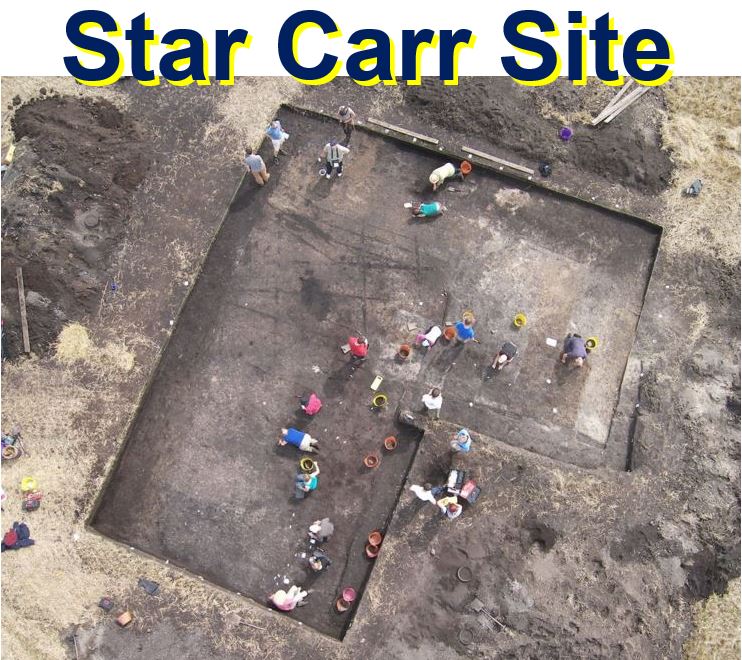Archaeologist have discovered an amazing 11000 year old engraved shale pendant at Star Carr, the Early Mesolithic site in North Yorkshire. They say the find is unique in the UK – no other engraved shale pendants have ever been discovered in Europe.
The archaeologists, from the Universities of Chester, Manchester and York, say this is the oldest known Mesolithic art in Britain.
The Mesolithic period, also called the Middle Stone Age, relates to the middle part of the Stone Age, between the Pelaeolithic and Neolithic – between about 12,000 and 7,000 years ago, when farming communities began to be established.
 This engraved shale pendant is the oldest known Mesolithic art in Britain. (Image: yorkshiremuseum.org.uk)
This engraved shale pendant is the oldest known Mesolithic art in Britain. (Image: yorkshiremuseum.org.uk)
Shale is fine-grained sedimentary rock that forms from the compaction of clay-size mineral particles and silt (commonly called ‘mud’). This places shale in a category of sedimentary rocks known as ‘mudstones’.
The research, which forms part of a 5-year project supported by the European Research Council, has been published in Internet Archaeology (citation below). The research is also supported by Historic England (old name English Heritage) and the Vale of Pickering Research Trust.
Shale pendant with lines engraved
The tiny, fragile pendant, measuring 31mm by 35mm and 3mm thick, was crafted from a single piece of shale. It contains a series of lines which archaeologists think may represent tally marks, a leaf, or perhaps a map.
This was a remarkable find, the team said; engraved motifs on Mesolithic pendants are very rare.
When the pendant was uncovered last year, the engraved lines on the surface were hardly visible. Scientists used a range of digital microscopy techniques to generate high-resolution images to help define the style and order of engraving.
 The pendant was found at the edge of a huge lake that used to exist in the Vale of Pickering thousands of years ago. (Image: yorkshiremuseum.org.uk)
The pendant was found at the edge of a huge lake that used to exist in the Vale of Pickering thousands of years ago. (Image: yorkshiremuseum.org.uk)
The pendant was also analysed to determine whether it had been strung or worn, and whether pigments had been used to make the lines stand out more.
See the pendant at the Yorkshire Museum
The pendant will be on public display at the Yorkshire Museum from 27th February to 5th May this year. The display will also feature other specimens discovered at Star Carr, including a rare barbed point used in hunting or fishing, 11,000 year old fire lighters, flints, and incredibly-well preserved birch bark rolls.
The items on display will have a digital interpretation and high imagery resolution next to them.
The Vale of Pickering, a low-lying flat area of land in North Yorkshire, had a huge lake in the Mesolithic times. Star Carr is one of several archaeological sites that once surrounded this lake.
Pendant found at ancient lake edge
This pendant was discovered in lake-edge deposits. Initially, researchers thought it was natural stone – the perforation was blocked by sediment and it was not possible to see the engravings.
It is the first perforated ancient relic with an engraved design discovered at Star Carr. Shale beads, as well as a piece of perforated amber, and two perforated animal teeth had been discovered at the site previously, but nothing like this.
 According to the Star Carr Archaeology Project: “Star Carr is a Mesolithic (Middle Stone Age) archaeological site, dating to around 9000 BC, just centuries after the end of the last Ice Age. It has become world famous in the archaeological world due to the preservation of artefacts found buried deep in the peat.” (Image: starcarr.com)
According to the Star Carr Archaeology Project: “Star Carr is a Mesolithic (Middle Stone Age) archaeological site, dating to around 9000 BC, just centuries after the end of the last Ice Age. It has become world famous in the archaeological world due to the preservation of artefacts found buried deep in the peat.” (Image: starcarr.com)
Co-author, Professor Nicky Milner, Deputy Head of the University of York’s Department of Archaeology, led the research. Prof. Milner said:
“It was incredibly exciting to discover such a rare object. It is unlike anything we have found in Britain from this period. We can only imagine who owned it, how they wore it and what the engravings actually meant to them.”
“One possibility is that the pendant belonged to a shaman — headdresses made out of red deer antlers found nearby in earlier excavations are thought to have been worn by shamans. We can only guess what the engravings mean but engraved amber pendants found in Denmark have been interpreted as amulets used for spiritual personal protection.”
 The Yorkshire Museum’s display – After the Ice: Yorkshire’s Prehistoric People – celebrates the county’s beginnings. It includes many of the artefacts and specimens discovered at Star Carr, including the 11,000-year-old engraved pendant. (Image: yorkshiremuseum.org.uk)
The Yorkshire Museum’s display – After the Ice: Yorkshire’s Prehistoric People – celebrates the county’s beginnings. It includes many of the artefacts and specimens discovered at Star Carr, including the 11,000-year-old engraved pendant. (Image: yorkshiremuseum.org.uk)
Sea level was lower at that time
Dr. Chantal Conneller, Senior Lecturer at the University of Manchester’s School of Arts, Languages and Cultures, who was co-director of excavations, said:
“This exciting find tells us about the art of the first permanent settlers of Britain after the last Ice Age. This was a time when sea-level was much lower than today. Groups roamed across Doggerland (land now under the North Sea) and into Britain.”
“The designs on our pendant are similar to those found in southern Scandinavia and other areas bordering the North Sea, showing a close cultural connection between northern European groups at this time.”
Dr. Barry Taylor, Archaeology Programme Leader and Lecturer in Archaeology at the University of Chester, who was co-director of the excavations, said:
“I love these sorts of finds because they are a real connection to people in the past. When we study prehistory we deal with very long periods of time and often focus on very broad issues. But this is something that a person wore, that had significance to them and to the people around them.”
“These sorts of artefacts tell us about people and, after all, that’s what archaeology is all about.”
Duncan Wilson, CEO of Historic England which contributed to and partly-funded the excavation and research publication said:
“The discovery of the pendant is a sensational find. Star Carr is an internationally important ‘at risk’ site, which is why we have provided substantial financial support for the excavation and assistance through the input of our specialist archaeological and archaeological science teams.”
“The results have exceeded our expectations and will help rewrite the story of this long and complex, but little understood early prehistoric period.”
Natalie McCaul, who works at the Yorkshire Museum as curator of archaeology, said:
“We are thrilled to be able to showcase such a nationally significant object for the first time. Its remarkable discovery changes the way we think about our ancestors who lived in Yorkshire 11,000 years ago and the rituals, beliefs and cultural values that were part of their lives.”
“We are excited that the rest of the collection from the excavations will come to the museum in time and we’re looking forward to preserving and displaying it for the public to enjoy.”
Researchers from the Centre for Digital Heritage, Hull York Medical School, and the Department of Physics at the University of York, were also involved in analyzing the pendant.
In an Abstract in the online journal, the authors wrote:
“This approach of using multiple scientific and analytical techniques has not been used previously and provides a methodology for the examination of similar artefacts in the future.”
Citation: “A Unique Engraved Shale Pendant from the Site of Star Carr: the oldest Mesolithic art in Britain,” Charlotte C.A. Rowley, Barry Taylor, Nicky Milner, Michael Bamforth, Gareth Beale, Julian C. Carty, Aimée Little, Andy Needham, Konstantinos Chatzipanagis, Shannon Croft, Roland Kroger, Chantal Conneller, Ben Elliott, Laura C. Fitton, Becky Knight & Harry K. Robson. Internet Archaeology 40. http://dx.doi.org/10.11141/ia.40.8.
Video – Star Carr Pendant
In this video, the researchers talk about their amazing find.
